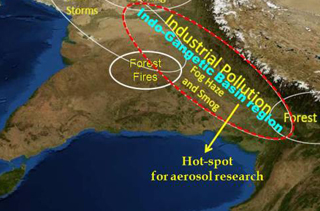Research News
1. Current knowledge in the aerosol trends over northern India
1.1 Aerosol built-up over India and south AsiaAtmospheric aerosols affect the global climatic system in many ways, by attenuating the solar radiation reaching the ground, modifying the solar spectrum, re-distributing the earth-atmosphere energy budget and influencing cloud microphysics and hydrological cycle. Atmospheric aerosols over south Asia constitute a major environmental and climate issue. Numerous studies dealt with analyzing the aerosol properties, focusing mainly on the spatio-temporal distribution of the Aerosol Optical Depth (AOD) and possible feedbacks of aerosols on climate and monsoon. With the increase in population, urbanization, industrialization and demands for energy, the aerosol load over India is gradually increasing having significant impact on continuation of the solar dimming phenomenon (Badarinath et al., 2010; Kambezidis et al., 2012).
Both ground-based measurements and satellite observations agree to an overall increase in AOD over Indian sub-continent (Ramachandran and Cherian, 2008; Moorthy et al., 2013). These studies limited mainly to yearly variations and trends; the monthly and/or seasonal trends of AOD over different sub-regions had not been analyzed so far. More recently, the aerosol trend analysis over India emphasizes also on seasonality, like the studies by Kharol et al. (2011) using sun photometer and MODIS observations over Hyderabad, Dey and Di Girolamo (2011) using MISR data over Indian subcontinent and adjoining oceanic areas, Kaskaoutis et al. (2011) using MODIS data
over south Asia with emphasis over Arabian Sea, Bay of Bengal, Northern Indian Ocean and Indo-Gangetic Plains (IGP), Kaskaoutis et al., (2012a) using AERONET data over Kanpur, Ramachandran et al. (2012) using MODIS data over the capitals of each Indian State, Lodhi et al. (2013) using sun photometer observations over Delhi. Overall, an increasing trend in aerosol loading is highlighted by all these studies (10.17% during 2000-2009 over whole South Asia, according to Kaskaoutis et al. 2011), which exhibits large spatio-temporal differences being more intense during winter season and, especially over northern India. The AERONET data over Kanpur, available till 2001, gives us the possibility of examining possible trends in the almucantar-derived parameters also, like size distribution, single scattering albedo and refractive index. Such an analysis (Kaskaoutis et al., 2012a) revealed that the statistically significant increasing trend in post-monsoon/winter AOD is reflected in a shift of the columnar size distribution towards relatively larger particles in the accumulation mode, indicating coagulation and condensation of the primarily fine aerosols over a progressively turbid environment. The concurrent increase (7.69%) in AOD500 and in Ångström exponent (5.5%) during the period 2001-2010 suggests an increase in anthropogenic aerosols over Kanpur, especially after 2005 (Fig. 1). The increasing aerosol emissions, mainly from anthropogenic activities, are responsible for the presence of the atmospheric brown clouds, which have significant climate implications in view of heating the middle and upper troposphere and influencing the monsoonal circulation (Ramanathan et al., 2007).
Current knowledge in the aerosol trends over northern India
 Heterogeneity in aerosol characteristics over the Indo-Gangetic Basin: Types and implications to radiative forcing
Heterogeneity in aerosol characteristics over the Indo-Gangetic Basin: Types and implications to radiative forcing
 Satellite-based estimation of PM2.5 distribution over India
Absorption enhancement by black carbon (BC) cored polydisperse aerosols under hygroscopic conditions
International Research News
Forthcoming Events
Satellite-based estimation of PM2.5 distribution over India
Absorption enhancement by black carbon (BC) cored polydisperse aerosols under hygroscopic conditions
International Research News
Forthcoming Events
Cover Image: (Left) Total changes in surface PM2.5 (µg m-3) during 2000-2010 based on MISR data (Courtesy: Dey et al., 2012, Rem. Sens. Environ, 127, 127-161) and (Right) trends in columnar aerosol optical depth (year-1) during 2000-2009 based on MODIS data (Courtesy: Kaskaoutis et al., 2011, Atmos. Meas. Tech. Discuss., 4, 5275-5323)





 Satellite-based estimation of PM2.5 distribution over India
Satellite-based estimation of PM2.5 distribution over India